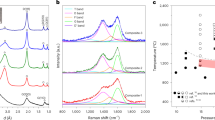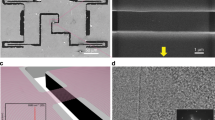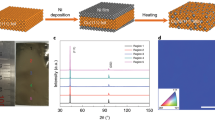Abstract
Atomically thin graphene exhibits fascinating mechanical properties, although its hardness and transverse stiffness are inferior to those of diamond. So far, there has been no practical demonstration of the transformation of multilayer graphene into diamond-like ultrahard structures. Here we show that at room temperature and after nano-indentation, two-layer graphene on SiC(0001) exhibits a transverse stiffness and hardness comparable to diamond, is resistant to perforation with a diamond indenter and shows a reversible drop in electrical conductivity upon indentation. Density functional theory calculations suggest that, upon compression, the two-layer graphene film transforms into a diamond-like film, producing both elastic deformations and sp2 to sp3 chemical changes. Experiments and calculations show that this reversible phase change is not observed for a single buffer layer on SiC or graphene films thicker than three to five layers. Indeed, calculations show that whereas in two-layer graphene layer-stacking configuration controls the conformation of the diamond-like film, in a multilayer film it hinders the phase transformation.
This is a preview of subscription content, access via your institution
Access options
Access Nature and 54 other Nature Portfolio journals
Get Nature+, our best-value online-access subscription
$29.99 / 30 days
cancel any time
Subscribe to this journal
Receive 12 print issues and online access
$259.00 per year
only $21.58 per issue
Buy this article
- Purchase on Springer Link
- Instant access to full article PDF
Prices may be subject to local taxes which are calculated during checkout




Similar content being viewed by others
Change history
21 May 2018
In the version of this Article originally published, the second affiliation for Walter A. de Heer had not been included; it should be ‘TICNN, Tianjin University, Tianjin, China’. This has now been added and the numbering of subsequent affiliations amended accordingly in all versions of the Article.
References
Cynn, H., Klepeis, J. E., Yoo, C. S. & Young, D. A. Osmium has the lowest experimentally determined compressibility. Phys. Rev. Lett. 88, 135701 (2002).
Narayan, J., Godbole, V. P. & White, C. W. Laser method for synthesis and processing of continuous diamond films on nondiamond substrates. Science 252, 416–418 (1991).
Jaglinski, T., Kochmann, D., Stone, D. & Lakes, R. S. Composite materials with viscoelastic stiffness greater than diamond. Science 315, 620–622 (2007).
Aust, R. B. & Drickamer, H. G. Carbon: A new crystalline phase. Science 140, 817–819 (1963).
Bundy, F. et al. The pressure-temperature phase and transformation diagram for carbon; updated through 1994. Carbon 34, 141–153 (1996).
Gorrini, F. et al. On the thermodynamic path enabling a room-temperature, laser-assisted graphite to nanodiamond transformation. Sci. Rep. 6, 35244 (2016).
Horbatenko, Y. et al. Synergetic interplay between pressure and surface chemistry for the conversion of sp 2-bonded carbon layers into sp 3-bonded carbon films. Carbon 106, 158–163 (2016).
Khaliullin, R. Z., Eshet, H., Kühne, T. D., Behler, J. & Parrinello, M. Nucleation mechanism for the direct graphite-to-diamond phase transition. Nat. Mater. 10, 693–697 (2011).
Mao, W. L. et al. Bonding changes in compressed superhard graphite. Science 302, 425–427 (2003).
Odkhuu, D., Shin, D., Ruoff, R. S. & Park, N. Conversion of multilayer graphene into continuous ultrathin sp 3-bonded carbon films on metal surfaces. Sci. Rep. 3, 3276 (2013).
Scandolo, S., Bernasconi, M., Chiarotti, G. L., Focher, P. & Tosatti, E. Pressure-induced transformation path of graphite to diamond. Phys. Rev. Lett. 74, 4015–4018 (1995).
Xie, H., Yin, F., Yu, T., Wang, J.-T. & Liang, C. Mechanism for direct graphite-to-diamond phase transition. Sci. Rep. 4, 5930 (2014).
Barboza, A. P. et al. Room-temperature compression-induced diamondization of few-layer graphene. Adv. Mater. 23, 3014–3017 (2011).
Rajasekaran, S., Abild-Pedersen, F., Ogasawara, H., Nilsson, A. & Kaya, S. Interlayer carbon bond formation induced by hydrogen adsorption in few-layer supported graphene. Phys. Rev. Lett. 111, 085503 (2013).
Luo, Z. et al. Thickness-dependent reversible hydrogenation of graphene layers. ACS Nano 3, 1781–1788 (2009).
Martins, L. G. P. et al. Raman evidence for pressure-induced formation of diamondene. Nat. Commun. 8, 96 (2017).
Kvashnin, A. G., Chernozatonskii, L. A., Yakobson, B. I. & Sorokin, P. B. Phase diagram of quasi-two-dimensional carbon, from graphene to diamond. Nano Lett. 14, 676–681 (2014).
Chernozatonskii, L. A., Sorokin, P. B., Kvashnin, A. G. & Kvashnin, D. G. Diamond-like C2H nanolayer, diamane: simulation of the structure and properties. JETP Lett. 90, 134–138 (2009).
Gao, Y. et al. Elastic coupling between layers in two-dimensional materials. Nat. Mater. 14, 714–720 (2015).
de Heer, W. A. et al. Large area and structured epitaxial graphene produced by confinement controlled sublimation of silicon carbide. Proc. Natl Acad. Sci. USA 108, 16900–16905 (2011).
Riedl, C., Coletti, C. & Starke, U. Structural and electronic properties of epitaxial graphene on SiC(0001): a review of growth, characterization, transfer doping and hydrogen intercalation. J. Phys. D 43, 374009 (2010).
Palaci, I. et al. Radial elasticity of multiwalled carbon nanotubes. Phys. Rev. Lett. 94, 175502 (2005).
Lucas, M., Mai, W., Yang, R., Wang, Z. L. & Riedo, E. Aspect ratio dependence of the elastic properties of ZnO nanobelts. Nano Lett. 7, 1314–1317 (2007).
Chiu, H. C., Kim, S., Klinke, C. & Riedo, E. Morphology dependence of radial elasticity in multiwalled boron nitride nanotubes. Appl. Phys. Lett. 101, 103109 (2012).
Berger, C. et al. Electronic confinement and coherence in patterned epitaxial graphene. Science 312, 1191–1196 (2006).
Kelly, B. T. Physics of Graphite (Springer, London, 1981).
Kumar, S. & Parks, D. M. Strain shielding from mechanically activated covalent bond formation during nanoindentation of graphene delays the onset of failure. Nano Lett. 15, 1503–1510 (2015).
Richter, A., Ries, R., Smith, R., Henkel, M. & Wolf, B. Nanoindentation of diamond, graphite and fullerene films. Diam. Relat. Mater. 9, 170–184 (2000).
Lucas, M., Gall, K. & Riedo, E. Tip size effects on atomic force microscopy nanoindentation of a gold single crystal. J. Appl. Phys. 104, 113515 (2008).
Deng, X., Chawla, N., Chawla, K. K., Koopman, M. & Chu, J. P. Mechanical behavior of multilayered nanoscale metal–ceramic composites. Adv. Eng. Mater. 7, 1099–1108 (2005).
Kulikovsky, V. et al. Hardness and elastic modulus of amorphous and nanocrystalline SiC and Si films. Surf. Coat. Technol. 202, 1738–1745 (2008).
Kvashnin, A. G. & Sorokin, P. B. Lonsdaleite films with nanometer thickness. J. Phys. Chem. Lett. 5, 541–548 (2014).
Wei, Z. et al. Nanoscale tunable reduction of graphene oxide for graphene electronics. Science 328, 1373–1376 (2010).
Berger, C. et al. in Graphene Growth on Semiconductors (eds N. Motta, F. Iacopi, & C. Coletti) 181–199 (Pan Stanford Publishing Pte, Singapore, 2016).
Filleter, T., Emtsev, K., Seyller, T. & Bennewitz, R. Local work function measurements of epitaxial graphene. Appl. Phys. Lett. 93, 133117 (2008).
Gallagher, P. et al. Switchable friction enabled by nanoscale self-assembly on graphene. Nat. Commun. 7, 10745 (2016).
Giannozzi, P. et al. QUANTUM ESPRESSO: a modular and open-source software project for quantum simulations of materials. J. Phys. Condens. Matter 21, 395502 (2009).
Kim, S. et al. Room-temperature metastability of multilayer graphene oxide films. Nat. Mater. 11, 544–549 (2012).
Perdew, J. P., Burke, K. & Ernzerhof, M. Generalized gradient approximation made simple. Phys. Rev. Lett. 77, 3865 (1996).
Grimme, S. Semiempirical GGA-type density functional constructed with a long-range dispersion correction. J. Comput. Chem 27, 1787–1799 (2006).
Acknowledgements
The authors acknowledge support from the Office of Basic Energy Sciences of the US Department of Energy (grant no. DE-SC0016204). E.T. thanks the European ERC (320796 MODPHYSFRICT). The authors acknowledge support from the CUNY High Performance Computing Center and the Extreme Science and Engineering Discovery Environment (XSEDE). The authors thank T. Wang for support with TEM measurements, C. Dean for insights on the C-AFM measurements, and M. Moseler for discussions on indentation simulations.
Author information
Authors and Affiliations
Contributions
Y.G. and F.C. performed nanomechanics experiments and data analysis. T.C. carried out DFT calculations and indentation simulations. E.R. conceived and designed the experiments and analysed the data. A.B. and E.T. analysed the experimental data and delineated the modelling strategy. C.B. and W.A.d.H. synthesized the EG samples. All authors contributed to writing the manuscript.
Corresponding authors
Ethics declarations
Competing interests
The authors declare no competing financial interests.
Additional information
Publisher’s note: Springer Nature remains neutral with regard to jurisdictional claims in published maps and institutional affiliations.
Supplementary information
Supplementary Information
Supplementary Figures 1–17, Supplementary references
Rights and permissions
About this article
Cite this article
Gao, Y., Cao, T., Cellini, F. et al. Ultrahard carbon film from epitaxial two-layer graphene. Nature Nanotech 13, 133–138 (2018). https://doi.org/10.1038/s41565-017-0023-9
Received:
Accepted:
Published:
Issue Date:
DOI: https://doi.org/10.1038/s41565-017-0023-9
This article is cited by
-
Pressure driven rotational isomerism in 2D hybrid perovskites
Nature Communications (2023)
-
Two-dimensional diamonds from sp2-to-sp3 phase transitions
Nature Reviews Materials (2022)
-
Relation between interfacial shear and friction force in 2D materials
Nature Nanotechnology (2022)
-
Tensile strain effects on electronic and optical properties of functionalized diamondene-like Si4
Journal of Materials Science (2021)
-
The unique carrier mobility of Janus MoSSe/GaN heterostructures
Frontiers of Physics (2021)



